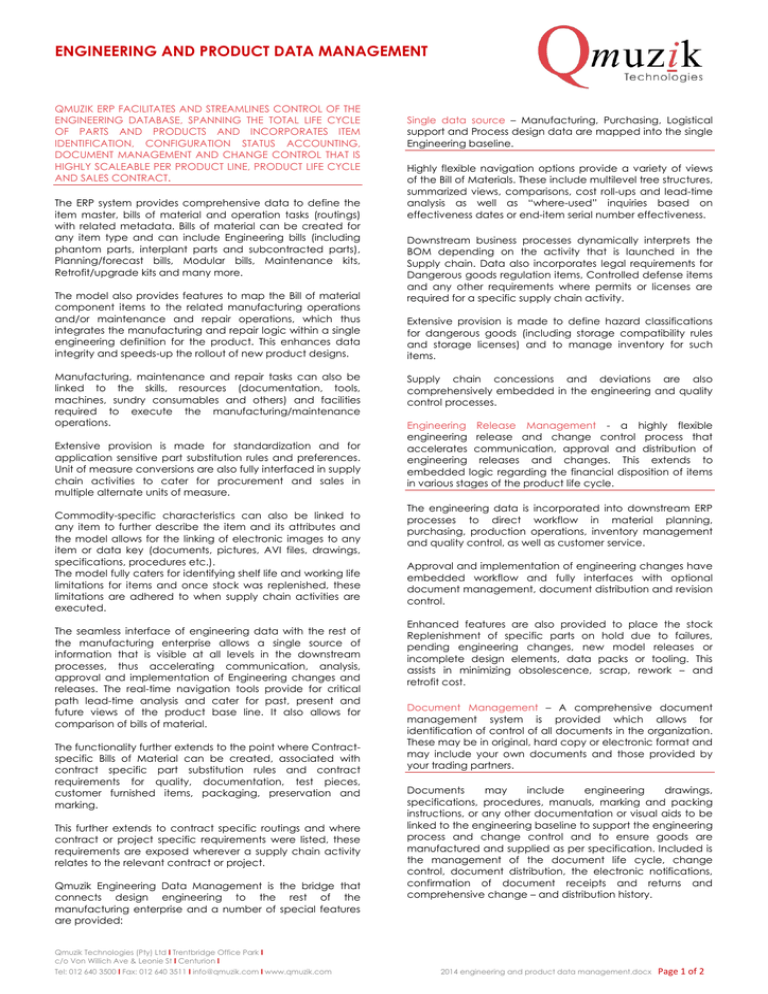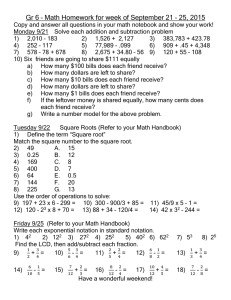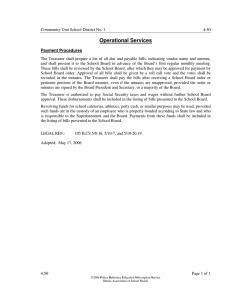ENGINEERING AND PRODUCT DATA MANAGEMENT
advertisement

ENGINEERING AND PRODUCT DATA MANAGEMENT QMUZIK ERP FACILITATES AND STREAMLINES CONTROL OF THE ENGINEERING DATABASE, SPANNING THE TOTAL LIFE CYCLE OF PARTS AND PRODUCTS AND INCORPORATES ITEM IDENTIFICATION, CONFIGURATION STATUS ACCOUNTING, DOCUMENT MANAGEMENT AND CHANGE CONTROL THAT IS HIGHLY SCALEABLE PER PRODUCT LINE, PRODUCT LIFE CYCLE AND SALES CONTRACT. The ERP system provides comprehensive data to define the item master, bills of material and operation tasks (routings) with related metadata. Bills of material can be created for any item type and can include Engineering bills (including phantom parts, interplant parts and subcontracted parts), Planning/forecast bills, Modular bills, Maintenance kits, Retrofit/upgrade kits and many more. The model also provides features to map the Bill of material component items to the related manufacturing operations and/or maintenance and repair operations, which thus integrates the manufacturing and repair logic within a single engineering definition for the product. This enhances data integrity and speeds-up the rollout of new product designs. Manufacturing, maintenance and repair tasks can also be linked to the skills, resources (documentation, tools, machines, sundry consumables and others) and facilities required to execute the manufacturing/maintenance operations. Extensive provision is made for standardization and for application sensitive part substitution rules and preferences. Unit of measure conversions are also fully interfaced in supply chain activities to cater for procurement and sales in multiple alternate units of measure. Commodity-specific characteristics can also be linked to any item to further describe the item and its attributes and the model allows for the linking of electronic images to any item or data key (documents, pictures, AVI files, drawings, specifications, procedures etc.). The model fully caters for identifying shelf life and working life limitations for items and once stock was replenished, these limitations are adhered to when supply chain activities are executed. The seamless interface of engineering data with the rest of the manufacturing enterprise allows a single source of information that is visible at all levels in the downstream processes, thus accelerating communication, analysis, approval and implementation of Engineering changes and releases. The real-time navigation tools provide for critical path lead-time analysis and cater for past, present and future views of the product base line. It also allows for comparison of bills of material. The functionality further extends to the point where Contractspecific Bills of Material can be created, associated with contract specific part substitution rules and contract requirements for quality, documentation, test pieces, customer furnished items, packaging, preservation and marking. This further extends to contract specific routings and where contract or project specific requirements were listed, these requirements are exposed wherever a supply chain activity relates to the relevant contract or project. Qmuzik Engineering Data Management is the bridge that connects design engineering to the rest of the manufacturing enterprise and a number of special features are provided: Qmuzik Technologies (Pty) Ltd l Trentbridge Office Park l c/o Von Willich Ave & Leonie St l Centurion l Tel: 012 640 3500 l Fax: 012 640 3511 l info@qmuzik.com l www.qmuzik.com Single data source – Manufacturing, Purchasing, Logistical support and Process design data are mapped into the single Engineering baseline. Highly flexible navigation options provide a variety of views of the Bill of Materials. These include multilevel tree structures, summarized views, comparisons, cost roll-ups and lead-time analysis as well as “where-used” inquiries based on effectiveness dates or end-item serial number effectiveness. Downstream business processes dynamically interprets the BOM depending on the activity that is launched in the Supply chain. Data also incorporates legal requirements for Dangerous goods regulation items, Controlled defense items and any other requirements where permits or licenses are required for a specific supply chain activity. Extensive provision is made to define hazard classifications for dangerous goods (including storage compatibility rules and storage licenses) and to manage inventory for such items. Supply chain concessions and deviations are also comprehensively embedded in the engineering and quality control processes. Engineering Release Management - a highly flexible engineering release and change control process that accelerates communication, approval and distribution of engineering releases and changes. This extends to embedded logic regarding the financial disposition of items in various stages of the product life cycle. The engineering data is incorporated into downstream ERP processes to direct workflow in material planning, purchasing, production operations, inventory management and quality control, as well as customer service. Approval and implementation of engineering changes have embedded workflow and fully interfaces with optional document management, document distribution and revision control. Enhanced features are also provided to place the stock Replenishment of specific parts on hold due to failures, pending engineering changes, new model releases or incomplete design elements, data packs or tooling. This assists in minimizing obsolescence, scrap, rework – and retrofit cost. Document Management – A comprehensive document management system is provided which allows for identification of control of all documents in the organization. These may be in original, hard copy or electronic format and may include your own documents and those provided by your trading partners. Documents may include engineering drawings, specifications, procedures, manuals, marking and packing instructions, or any other documentation or visual aids to be linked to the engineering baseline to support the engineering process and change control and to ensure goods are manufactured and supplied as per specification. Included is the management of the document life cycle, change control, document distribution, the electronic notifications, confirmation of document receipts and returns and comprehensive change – and distribution history. 2014 engineering and product data management.docx Page 1 of 2 ENGINEERING AND PRODUCT DATA MANAGEMENT Project Management - the Engineering model fully interfaces with the system’s Project Management model to plan, budget, and control and authorize expenses for engineering development and to enforce time and cost constraints for activities in the work break down structure (WBS). The project WBS can also be mapped into the engineering hardware structure, thus enabling MRP to suggest the applicable element in the project WBS when planned replenishments are created for purchasing and manufacturing activities at all levels in the BOM. Single integrated routing - a Single integrated routing definition for both "manufacturing" and "maintenance" scenarios are provided and the mapping of these operations into the bill of material items embeds the manufacturing process into the engineering design. Online, Real-time Visibility – full integration with downstream ERP processes provides timely, online visibility of up-to-date engineering data. Comprehensive functionality is included for routing steps performed externally by Suppliers. The tools provided for comparison of bills of material as well as the simulation capabilities of MRP can also be applied for “what-if” scenarios regarding engineering changes and to test feasibility and timing of suggested changes and to analyse and minimise the potential cost of scrap, obsolescence, modification and/or retrofits. Customer Contract specific baselines – As an alternative to implementing engineering changes effective from specified dates, functionality is s provided to implement engineering changes from a specified configuration end-item serial number, thus eliminating many of the factors that traditionally interfere with correctly timing the implementation and thus minimising obso-lescence. Back flushing rules for labour report back and post deduction of inventory balances from predefined WIP-stores and flow racks are fully integrated with the product design and the manufacturing steps defined in the routing. Serial Number tracking, Installed Positions and Audit trail – multiple, excellent serial and lot number control options are provided, fully interfaced with build history and visibility of installed positions of serial numbers as per drawing annotations and references. Includes the ability to save a snapshot of the engineering base line at time of order launching/release, for comparison to the eventual as-built configuration of the product. This eventually also extends to the as-maintained structure of the equipment after shipping, with comprehensive features to record equipment history, failures, maintenance events and upgrades. Spare parts (LRU’s) identification and Maintenance/repair requirements are much enhanced since the exact configuration and build history of every end-item becomes visible. The interface with Customer service and contract management further allows for contract specific part substitution rules and for the exposure of contract specific requirements for quality, packing, marking, documentation and others. Qmuzik Technologies (Pty) Ltd l Trentbridge Office Park l c/o Von Willich Ave & Leonie St l Centurion l Tel: 012 640 3500 l Fax: 012 640 3511 l info@qmuzik.com l www.qmuzik.com 2014 engineering and product data management.docx Page 2 of 2


